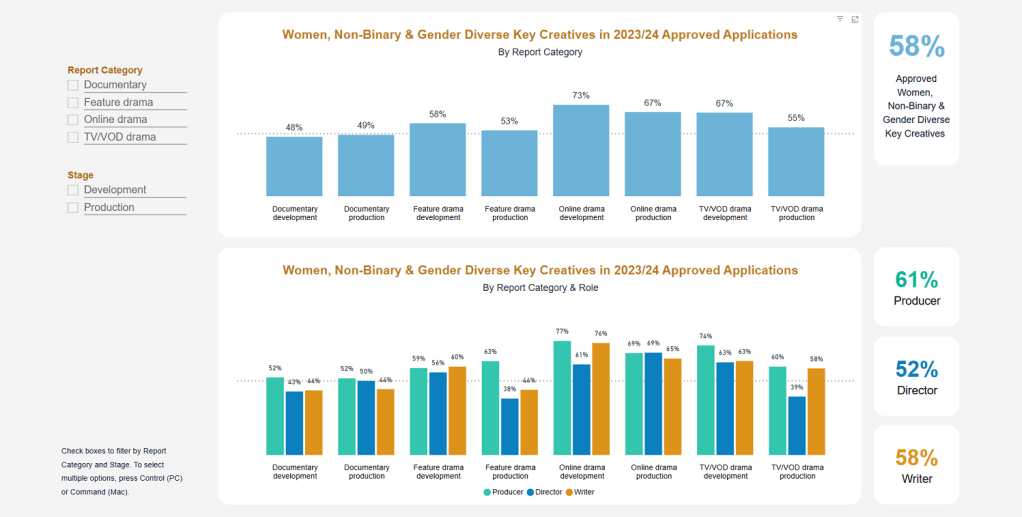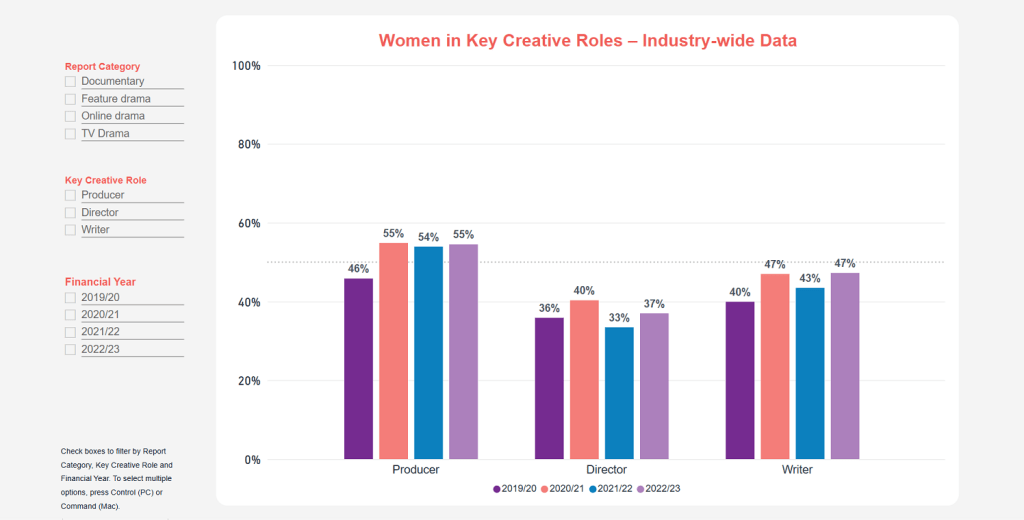Screen Australia believes it is on track to meet its new Gender Matters KPI but has acknowledged more needs to be done to support equity across writing and directing.
The agency has released its 2023/24 outcomes for the three-year KPI, which outlines that 50 per cent of the key creative roles – defined as producer, director, and writer – across all projects receiving Screen Australia development and production funding to be occupied by women, non-binary and/or gender diverse people across a three-year average from 2023/24 to 2025/26.
This is the first year the reporting has expanded to include non-binary and gender-diverse representation. Games data is not counted towards this KPI due to differences in key roles.
According to the results, 58 per cent of key creative roles across approved development and production funding are held by women, non-binary and/or gender diverse people, including 61 per cent of producer roles, 58 per cent of writer roles and 52 per cent of director roles.
However, it has coincided with industry-wide gender representation data for the 2022/23 financial year showing that women made up less than 50 per cent of producers, writers and directors in feature drama.
Speaking about the results Screen Australia COO Grainne Brunsdon said it was important to reflect on the scope and capacity of the initiative.

“We are encouraged by the growing representation of non-binary and gender diverse people, and for women to have reached or exceeded parity in many categories across successful Screen Australia applications,” she said.
“While the 58 per cent result for the most recent financial year is heartening, this has been influenced by a higher proportion of women, non-binary and/or gender diverse people in producer roles [61 per cent].
“We know directors and writers are an area of focus particularly in feature drama production and more work is needed to support equity in these fields.”
A further breakdown of Screen Australia development applications, as outlined by the agency, reveals that 60 per cent of development roles were held by women, non-binary and/or gender diverse people. This was led by online drama development (73 per cent) and TV/VOD drama development (67 per cent), followed by feature drama development at 58 per cent, and documentary development, which sits below parity at 48 per cent.
Producers are most represented in the development categories, with 77 per cent for online drama development, 74 per cent for TV/VOD drama development, 59 per cent for feature drama development, and 52 per cent for documentary development.
Writers were above parity for three out of four categories, with online drama development at 76 per cent, TV/VOD drama development at 63 per cent, and feature drama development at 60, while documentary development writers were at 44 per cent. Directors were the least represented, with 63 per cent for TV/VOD drama development, 61 per cent for online drama development, and 56 per cent for feature drama development.

There was a similar trend in the production categories, where women, non-binary and/or gender diverse people represented 59 per cent of producers.
However, in feature drama production, writers and directors were below parity at 44 per cent and 38 per cent respectively. TV/VOD drama production fared slightly better with women, non-binary, and/or gender-diverse people representing 58 per cent of writers and 39 per cent of directors.
Overall, documentary production had the lowest level of representation across production categories, with 49 per cent of women, non-binary and/or gender diverse people across all key creative roles. Producers and directors reached parity at 52 per cent and 50 per cent, respectively, while writers were 44 per cent.
Online drama was reported as having the greatest overall representation, with writers, directors, and producers at 65 per cent, 69 per cent, and 69 per cent, respectively.
‘Need for further conversation’
As per industry-wide gender representation data for the 2022/23 financial year, women occupied 46 per cent of all key creative roles in 2022/23, representing 55 per cent of all industry-wide producer roles, 37 per cent of director roles, and 47 per cent of writer roles.
They were best represented in online drama (57 per cent), followed by TV drama (48 per cent) documentary (47 per cent) and feature drama (32 per cent).
Online was the only category to exceed 50 per cent representation across all three key creative roles with writers at 63 per cent, producers at 56 per cent and directors at 52 per cent.
In documentary, women made up 57 per cent of producers, 48 per cent of writers, and 37 per cent of directors. It was a similar story in TV drama, where women accounted for 59 per cent of producers, 49 per cent of writers and 37 per cent of directors.
However, in feature drama, there was a clearer disparity between women producers (46 per cent) and directors (22 per cent), and writers (29 per cent), with all three categories below parity.
Brunsdon said the industry-wide data “highlighted the need for further conversation and action around gender equity, inclusion and access”, for which collaboration would be “essential”.
“We look forward to working with industry to achieve genuine representation in our screen industry,” she said.
Find the data here.


